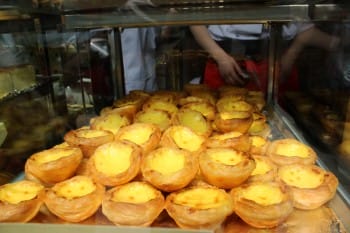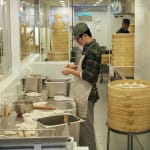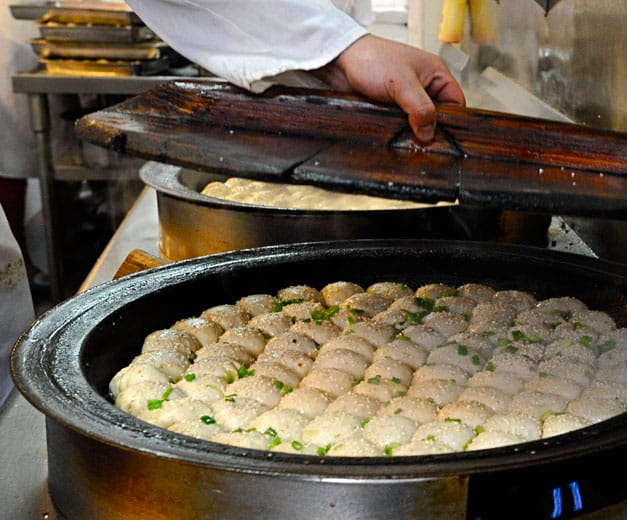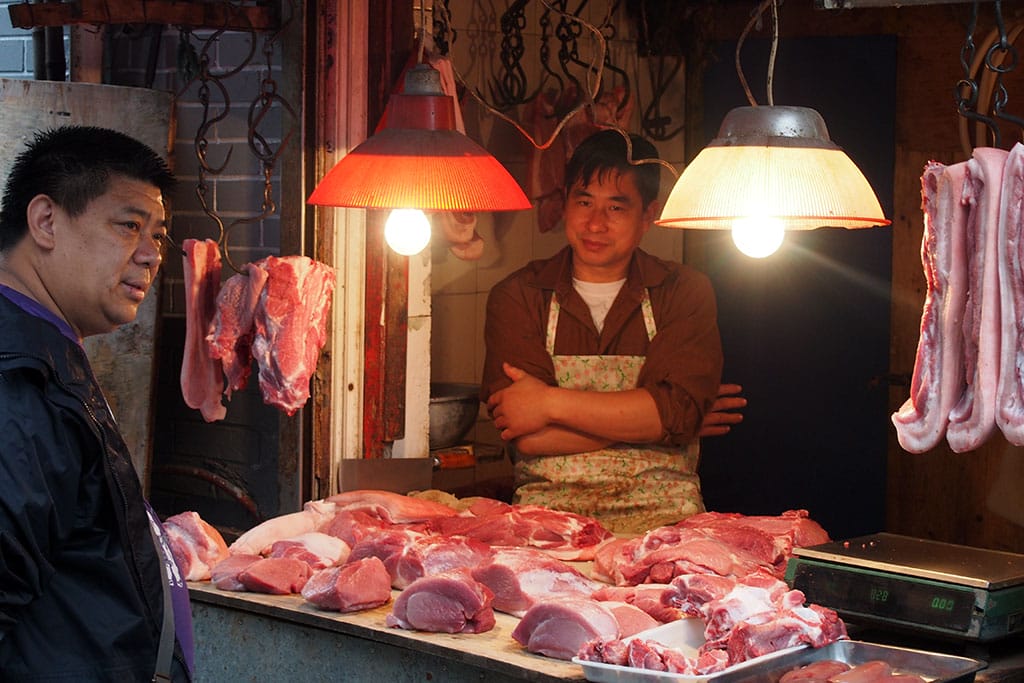Editor’s note: In the latest installment of our recurring feature, First Stop, we asked Lillian Chou, former food editor of Gourmet and now a freelance writer in Beijing, where she heads first for food when she arrives in Shanghai.
There are several factors that decide where I eat first when I arrive in Shanghai – mostly, it’s whether I’m alone or with friends and what kind of eaters they are and how much time we have.
As a visitor, I still find joy in the stalwart favorites that I can’t get in Beijing. If I’m with a first-time visitor during the daytime, I generally go to Yang’s Fry Dumpling, which has several locations. The original used to be on Wujiang Lu, in one of the best locations for street food, but that’s now a construction site (sigh). They have expanded with success, and many branches are in shopping malls with sterile settings and no character. But I like walking through the matchmaking market at People’s Park toward the Yang’s on Huanghe Lu. It’s not the most charming location – a bit sanitary – but customers can watch the dumplings being made and cooked fresh in giant pans. Shēngjiān bāo (生煎包) are the star here. They are like bigger, fatter versions of soup dumplings, but with a bready wrapping and a crunchy, golden-fried bottom similar to a pan-fried dumpling. The filling is a juicy, sweet pork prize that is screaming hot. It’s easy to ruin shirts with the broth. The cooks use stained, bent cardboard as potholders to lift the traditional wooden lids that allow the steam to escape from huge, flat iron pans. It’s a brilliant technique of steaming and frying in a single vessel. The dumplings are sprinkled with sesame and scallions and come four per order for about $1.
I go to that branch because right across from there is one of my absolute favorite places for soup dumplings (小笼包, xiǎolóngbāo), and we finish with a foot massage, so it’s a lot of bird-killing in one location. There is no English sign, but it’s called 佳家汤包 (Jiā Jiā Tāngbāo), and the soup dumplings there are made to order. There is actually an English menu that’s surrendered after they let you struggle (Commie-style), but Chinese tiles list the day’s available fillings. Pure pork or pork and crab or pure crab (the most expensive, but worth it) are the best options. Ask for ginger on the side for 1 RMB more. You’ll wait – and you may have to share a table – but it’s worth it. If both restaurants have long lines, I pay and get the chits from each and drift back and forth to save the wait.
If it’s just me and it’s daytime, I go to Ruijin Erlu and Nanchang Lu, where Fengyu (丰裕餐饮), a local noodle shop with a state-owned branch, offers those buns/dumplings but on a less accessible level: no English at all, and it’s a bit rough and tumble. I find that some folks who are more prudent think it’s grungy, but it’s this kind of eatery that has a line out the door during hungry hours. There are other items too. I usually ask for their pork and vegetable wonton soup with floating bits of egg and seaweed or, if I’m hungrier, an order of shēngjiān bāo and a bowl of scallion oil noodles (葱油伴面, cōng yóu bàn miàn), which is a very Shanghai dish. It’s boiled wheat noodles mixed together with caramelized scallions in their sweet, fragrant oil – delicious and simple.
 If it’s later in the day and I don’t want savory – which is rare – I will head to Lillian’s Cake Shop (many locations in town) for a Portuguese-style egg custard tart (which is also the only thing I would get there). It’s not correct to say it’s the traditional Cantonese egg tart, which doesn’t have a charred top, but it goes by the same name, dàntà, or 蛋挞. There’s rumor that KFC, which is big here, tried to purchase the recipe, but Lillian wouldn’t sell. Not everyone loves these tarts; they lack vanilla, which, when I make them, do make a huge difference. But they are cheap and cheerful with a flaky crust, while Chinese traditional tarts are made with a shortcrust lard dough. I don’t mind either version, and when I bite into the rich custard, it always brings me sweet memories.
If it’s later in the day and I don’t want savory – which is rare – I will head to Lillian’s Cake Shop (many locations in town) for a Portuguese-style egg custard tart (which is also the only thing I would get there). It’s not correct to say it’s the traditional Cantonese egg tart, which doesn’t have a charred top, but it goes by the same name, dàntà, or 蛋挞. There’s rumor that KFC, which is big here, tried to purchase the recipe, but Lillian wouldn’t sell. Not everyone loves these tarts; they lack vanilla, which, when I make them, do make a huge difference. But they are cheap and cheerful with a flaky crust, while Chinese traditional tarts are made with a shortcrust lard dough. I don’t mind either version, and when I bite into the rich custard, it always brings me sweet memories.
(top photo by Lillian Chou, above photo by UnTour Shanghai)
Yang’s Fry Dumpling (many locations)
Address: 97 Huanghe Lu, Huangpu
黄河路97号
Telephone: +86 21 5375 1793
Hours: 6:30am-8pm
Jia Jia Tangbao
Address: 90 Huanghe Lu, Huangpu
黄河路90号
Telephone: +86 21 6327 6878
Hours: 6:30am-6:30pm
Fengyu (Nanchang Lu branch) 上海丰裕餐饮 (南昌路店)
Address: 41 Ruijin Er Lu, Xuhui
上海市徐汇区瑞金二路41号
Telephone: +86 21 5306 1742
Hours: 6am-8:30pm
 January 25, 2016 Top Buns
January 25, 2016 Top Buns
Bāozi (包子), or steamed buns, are a basic, on-the-go meal. It’s rare to come across a […] Posted in Shanghai September 2, 2019 Yang Yang’s Dumplings
September 2, 2019 Yang Yang’s Dumplings
Search online for Shanghai’s best fried dumplings, and you’ll come up with hundreds of […] Posted in Shanghai October 20, 2015 Ask CB
October 20, 2015 Ask CB
Dear Culinary Backstreets,
I’ve heard about “wet markets,” but what are they exactly? […] Posted in Shanghai
Published on May 10, 2014
Related stories
January 25, 2016
ShanghaiBāozi (包子), or steamed buns, are a basic, on-the-go meal. It’s rare to come across a shop selling these buns for more than 1.5 RMB (US$0.25), and yet, the past five years have seen a dramatic rise in the stature of this humble dish – thanks mostly to celebrity chef David Chang, whose Momofuku pork…
September 2, 2019
ShanghaiSearch online for Shanghai’s best fried dumplings, and you’ll come up with hundreds of results extolling Yang’s Fried Dumplings. Though it was once just a humble shop sandwiched between the Bund and People’s Square, the online renown and ensuing crowds have propelled the brand into chain-store ubiquity, populating new malls and shopping streets with fervor.…
October 20, 2015
ShanghaiDear Culinary Backstreets, I’ve heard about “wet markets,” but what are they exactly? And where can I find the best wet markets in Shanghai? Stocked with all the fresh produce and live seafood that hungry Shanghai residents could ever cook up, wet markets are an essential alternative to the brand-name supermarkets vying for their slice…

















































































